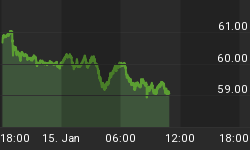Below is an excerpt from a commentary originally posted at www.speculative-investor.com on 22nd March 2012.
In our 19th March commentary, we wrote:
"The HUI is probably going to make a short-term bottom within the next three weeks, but speculators who focus on gold and silver stocks should be financially and emotionally prepared for frustrating back-and-forth price action to continue until at least the final quarter of this year."
The reasoning behind this statement has been covered a number of times in TSI commentaries over the past 9 months, but it is worth reiterating. The first of two main reasons was described as follows in our 30th November 2011 discussion about the Barrons Gold Mining Index (BGMI):
"After the 60s-70s bull market reached the top of a major upward leg (the points labeled 1 and 2 on our BGMI chart), more than 5 years elapsed before there was a decisive break to a new all-time high. If the current market does something similar then there won't be a decisive break into new all-time-high territory prior to the second quarter of 2013. The point, here, is that the gold sector's seeming inability over the past 12 months to embark on a powerful new upward trend is consistent with what happened during the previous long-term bull market."

And:
"...we shouldn't blindly assume that the current long-term bull market will continue to track the earlier long-term bull market. Real-time analysis is required at each step along the way, because the current market could end up doing better or worse than the earlier one in response to contemporary fundamental developments. We are simply trying to show that the frustration being experienced by today's holders of gold stocks was most likely also experienced by holders of gold stocks at a similar stage of the 60s-70s bull market. In fact, the level of frustration could have been higher back then because this time around the BGMI was quicker to recoup the losses incurred during its first major correction."
In our 2102 Yearly Forecast we repeated the above comments and went on to say:
"Real-time analysis will continue to be the primary influence on our expectations, but it makes sense to also keep the 60s-70s pattern in mind. The fact is that despite the important fundamental differences between today's situation and the situation four decades ago, on a 'big picture' basis the current bull market in gold stocks is unfolding in similar fashion to the earlier one.
Perhaps the best way to view the current situation is to accept that while the bull market's next major upward leg could soon begin, there's a realistic chance -- based on the historical pattern -- that it won't begin until next year."
The second of the two main reasons relates to the silver market's spectacular 2010-2011 rally and has also been covered in earlier TSI commentaries. It can be summarised as follows:
After silver completes a parabolic rise that results in a weekly RSI of more than 80 and a Market Vane bullish percentage in the 90s (ideally, 95 or more), the correction low is typically put in place within 8 months of the peak but the overall correction tends to last a minimum of 15 months. To illustrate what we mean, peaks over the past 10 years that meet the aforementioned criteria have been labeled "A" on the following weekly chart. The points labeled "B" on the chart are the correction lows and the points labeled "C" are when we deem the overall 'corrective' process to be complete.
The distance from "A" to "C" was 15-17 months during each of the prior corrections of the past 10 years. Given that silver was more 'overbought' at its late-April 2011 peak than at any of the preceding three peaks, it is unlikely that the current correction will end up being shorter than the shortest of the preceding episodes. It is more likely to last 17 months or longer. To be more specific, the current correction's price low was probably put in place during December of last year, but the choppy trading that constitutes 'corrective activity' probably won't be complete before September of this year.

While the idea that the next major advance won't begin until at least the final quarter of this year is primarily based on historical price action as discussed above, it also has a fundamental basis. The fundamental basis is that economic confidence is presently on the rise, leading to the conclusion in the collective mind of the investing community that central banks will no longer feel the need to aggressively promote inflation. This explains why gold and other 'safe havens' are falling out of favour. The upward trend in economic confidence probably won't last much longer, but once it ends -- as indicated by a downward reversal in the stock market -- it wouldn't be normal for gold-related investments to immediately benefit. A normal sequence would go something like this:
1. The stock market reverses downward on an intermediate-term basis, indicating the start of a multi-quarter decline in economic confidence.
2. During the first few months of the downturn, cash -- especially the US$ variety -- is king.
3. The Fed panics and either introduces new inflation-promoting schemes or clearly hints that such schemes are in the offing.
4. Gold begins to trend upward in anticipation of more Fed profligacy and its deleterious effects on money and the economy.
In other words, economic trends, or at least the general perception of the economy's trend, could push the starting points of the next major advances in the prices of gold, silver and the associated equities out to at least the final quarter of this year. In the interim there would be tradable rallies, but these rallies would end prematurely.
We aren't offering a free trial subscription at this time, but free samples of our work (excerpts from our regular commentaries) can be viewed at: http://www.speculative-investor.com/new/freesamples.html
















